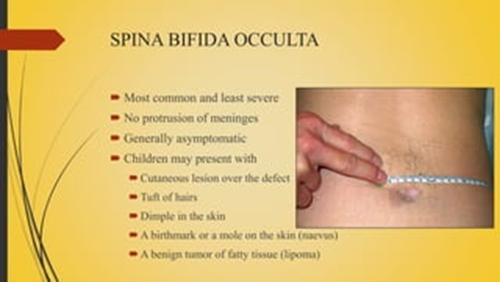A nurse is caring for an infant who has spina bifida. Which of the following actions should the nurse take?
Place the infant in prone position.
Cover the infant's lesion with a dry cloth.
Feed the infant through an NG tube.
Diapering over a low defect will keep the infant free from infection
The Correct Answer is D
A. Place the infant in prone position.
This option is incorrect. Placing the infant in the prone position (lying on the stomach) could put pressure on the spinal lesion, potentially causing discomfort or complications. It's important to minimize pressure on the affected area in infants with spina bifida.
B. Cover the infant's lesion with a dry cloth.
This option is incorrect. While keeping the lesion clean and dry is important for preventing infection, simply covering it with a dry cloth may not provide adequate protection. Proper wound care techniques, such as using sterile dressings and cleaning the area with prescribed solutions, are typically necessary to prevent infection and promote healing.
C. Feed the infant through an NG tube.
This option is incorrect. While infants with severe forms of spina bifida may have difficulty feeding due to associated complications, such as difficulty swallowing or weak sucking reflexes, feeding through a nasogastric (NG) tube is not a standard intervention for spina bifida itself. Feeding methods would depend on the specific needs and abilities of the infant, and may involve breastfeeding, bottle-feeding, or other methods under the guidance of healthcare professionals.
D. Diapering over a low defect will keep the infant free from infection.
This option is correct. Diapering over a low defect (the opening in the spine caused by spina bifida) helps to keep the area clean and reduce the risk of infection. By properly covering the defect with a diaper, exposure to urine and feces, which can increase the risk of infection, is minimized. Additionally, regular diaper changes and proper hygiene practices are essential for preventing complications in infants with spina bifida.
Nursing Test Bank
Naxlex Comprehensive Predictor Exams
Related Questions
Correct Answer is D
Explanation
A. Flaccid paralysis of lower extremities:
Flaccid paralysis refers to a weakness or loss of muscle tone in the affected muscles, leading to decreased or absent movement. This finding is not typically associated with spina bifida occulta. Instead, it is more commonly seen in more severe forms of spina bifida, such as myelomeningocele, where there is significant involvement of the spinal cord and nerves.
B. Hip dislocation:
Hip dislocation can occur in individuals with myelomeningocele due to muscle weakness, abnormal muscle tone, and joint deformities associated with spinal cord defects. However, it is not typically associated with spina bifida occulta, which usually presents with less severe spinal cord involvement.
C. Hydrocephalus:
Hydrocephalus, characterized by the accumulation of cerebrospinal fluid within the brain, is a common complication of myelomeningocele due to disturbances in the flow and absorption of cerebrospinal fluid caused by the spinal defect. It is less commonly associated with spina bifida occulta, which typically involves a less severe spinal cord defect.
D. Dimple in sacral area:
This is the correct choice. A dimple, patch of hair, or birthmark in the lower back or sacral area is a common finding in spina bifida occulta. It occurs due to the incomplete closure of the spinal column during fetal development, leading to a small defect in the vertebrae. This is often a subtle manifestation of spina bifida occulta and may not cause significant symptoms or functional impairment.

Correct Answer is C
Explanation
A. Measure the elixir in a medicine cup before transferring to a syringe:
This option involves measuring the medication using a medicine cup before transferring it to an oral medication syringe. While measuring the medication accurately is important, transferring it from a medicine cup to a syringe introduces an extra step that may increase the risk of spillage or dosage error. It's generally more efficient and accurate to directly draw the medication into the oral syringe.
B. Place the infant supine in a crib prior to administration:
Placing the infant in a supine (lying flat on the back) position in a crib prior to administering oral medication is not recommended, particularly for infants of this age. This position increases the risk of choking or aspiration, as it may cause the medication to flow toward the back of the throat rather than being swallowed properly. It's safer to administer oral medication to infants in an upright or slightly reclined position.
C. Position the syringe to the side of the infant's tongue:
This is the correct choice. Positioning the syringe to the side of the infant's tongue helps facilitate swallowing and reduces the risk of choking or aspiration. Placing the syringe toward the cheek allows the infant to more easily swallow the medication, as it minimizes the chance of the medication flowing toward the back of the throat.
D. Mix the medication with 10 mL of formula:
Mixing medication with formula is not a standard practice for administering oral medication using an oral syringe, particularly without specific instructions from the healthcare provider. Mixing medication with formula may alter the medication's effectiveness and is unnecessary for most oral medications. It's important to administer oral medication directly using an oral syringe to ensure accurate dosing and effectiveness.
Whether you are a student looking to ace your exams or a practicing nurse seeking to enhance your expertise , our nursing education contents will empower you with the confidence and competence to make a difference in the lives of patients and become a respected leader in the healthcare field.
Visit Naxlex, invest in your future and unlock endless possibilities with our unparalleled nursing education contents today
Report Wrong Answer on the Current Question
Do you disagree with the answer? If yes, what is your expected answer? Explain.
Kindly be descriptive with the issue you are facing.
